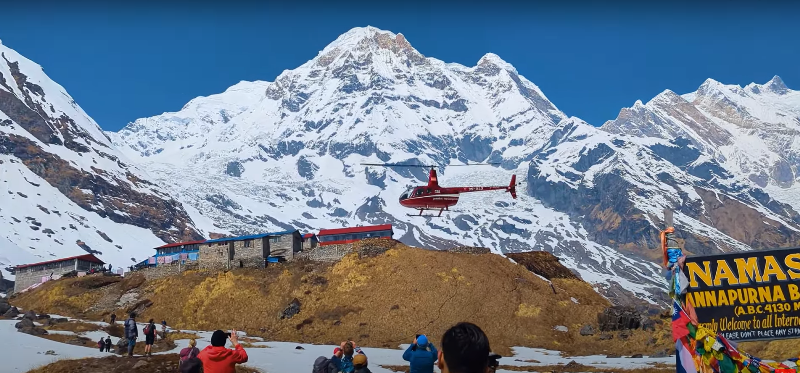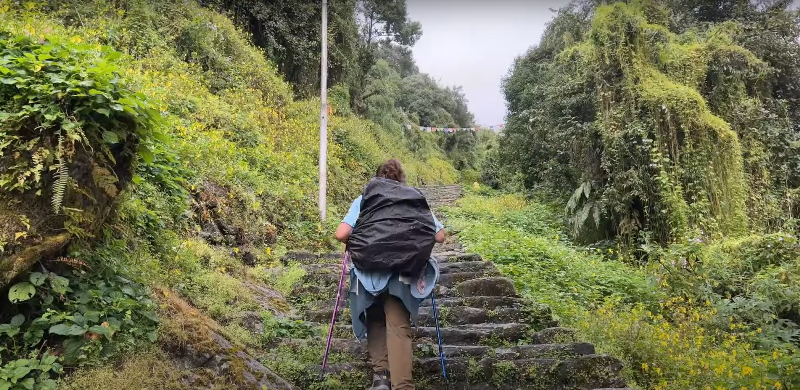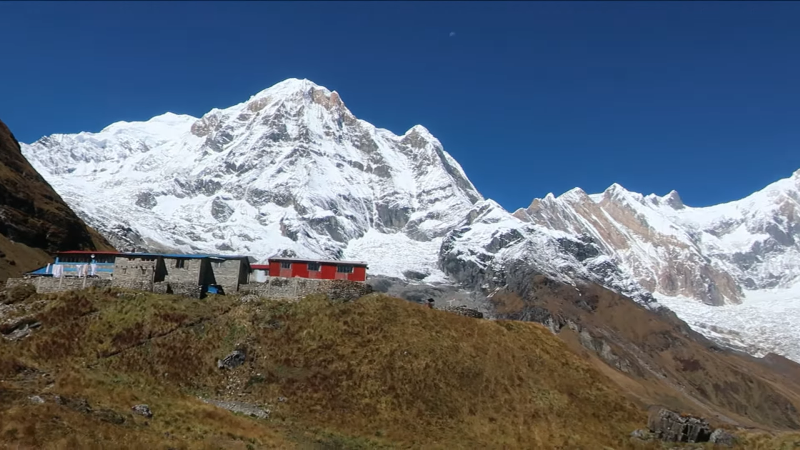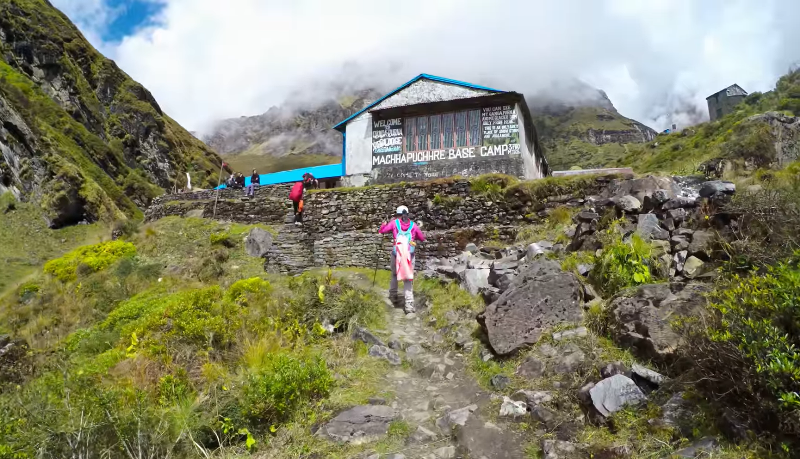December 7, 2023

The weather at Annapurna Base Camp varies significantly from month to month, offering a diverse experience for trekkers. In the spring months of March to May, the weather is generally mild and stable, with temperatures ranging from 10 to 20 degrees Celsius. This is an ideal time for trekking, as the rhododendron forests bloom in a riot of colors.
June marks the onset of the monsoon season, bringing heavy rainfall and making the trails slippery. July and August experience persistent rain, increasing the risk of landslides. Trekking during these months is challenging, with limited visibility and difficult trail conditions.
September brings the post-monsoon period, with clearer skies and lush landscapes. October and November are considered the best months for trekking, offering crisp and stable weather, with temperatures ranging from 5 to 15 degrees Celsius. December to February is winter, bringing colder temperatures and occasional snowfall, making trekking more demanding but rewarding for those seeking a quieter experience amidst the snow-capped peaks.
In the month of January, Annapurna Base Camp (ABC) is characterized by rigorous winter conditions, marked by notably low temperatures and substantial snowfall. Diurnal temperatures typically range between 5 to 10 degrees Celsius (41 to 50 degrees Fahrenheit), while nocturnal temperatures frequently plummet well below freezing. The trail leading to ABC is rendered arduous by the pervasive snow cover, necessitating the use of specialized equipment for safe and effective trekking. Unpredictable weather patterns manifest in intermittent snowstorms and icy terrains, demanding a high degree of preparedness from travelers.
Given these challenges, it is imperative for visitors to equip themselves with insulated clothing, waterproof attire, and other essentials conducive to traversing snow-laden landscapes. Furthermore, an acute awareness of potential visibility limitations is paramount. Despite the formidable conditions, the ethereal beauty of Annapurna enveloped in winter’s embrace renders the journey an unparalleled and gratifying expedition, making it an experience that, with meticulous preparation, offers an extraordinary encounter with the Himalayan wilderness.

Annapurna base camp with snow cover view
In February, Annapurna Base Camp experiences cold temperatures and occasional snowfall. Daytime temperatures range from 5 to 12 degrees Celsius (41 to 54 degrees Fahrenheit), while nighttime temperatures can drop below freezing. The trekking trails may be covered with snow and ice, requiring appropriate gear like insulated boots and trekking poles. Visibility may be reduced due to snowfall, but on clear days, the views of the surrounding peaks, including Annapurna I and Machapuchare, can be stunning. It’s crucial to be well-prepared for cold conditions, dress in layers, and check weather updates regularly. Trekking with a knowledgeable guide is recommended for safety in this winter month.
March marks the end of winter and the beginning of spring in the Annapurna region. During this time, the weather in the Annapurna Base Camp area can be quite pleasant, with gradually rising temperatures. However, it’s essential to be prepared for a mix of conditions, as the transition from winter to spring can bring some variability.
Temperature: Daytime temperatures in March at Annapurna Base Camp typically range from 5 to 15 degrees Celsius (41 to 59 degrees Fahrenheit). However, temperatures can drop significantly at night, often falling below freezing, so be prepared for cold evenings and mornings.
Precipitation: March is considered a relatively dry month in the Annapurna region. While there might be some occasional rain or snowfall, precipitation levels are generally lower compared to the winter months.
Visibility: March offers relatively good visibility for trekking and enjoying the breathtaking mountain scenery. Clear skies during the day provide excellent views of the surrounding peaks, including Annapurna I, Machapuchare, and others.
Trail Conditions: The trekking trails leading to Annapurna Base Camp may still have remnants of snow and ice, especially at higher elevations. Proper trekking gear, including sturdy boots and trekking poles, is advisable.
Clothing: Dressing in layers is crucial for March trekking. Bring warm clothing for the cold mornings and evenings, along with lighter layers for the warmer daytime temperatures. A good-quality waterproof jacket and pants are also recommended in case of rain or snow.
It’s important to note that weather conditions can vary, and unexpected changes may occur. Therefore, it’s advisable to check with local authorities, trekking agencies, or weather services for the most up-to-date information before planning your trip. Additionally, hiring a local guide who is familiar with the region and its weather patterns can enhance your overall trekking experience and safety.
April is a favorable time to trek to Annapurna Base Camp (ABC) as the region experiences mild and pleasant weather during this period. The temperatures at ABC in April range from approximately 10 to 15 degrees Celsius during the day, making it a comfortable environment for trekking. The days are generally clear, offering breathtaking views of the surrounding snow-capped peaks, including the majestic Annapurna massif.
However, it’s essential to be prepared for cooler temperatures in the evenings and mornings, with temperatures dropping to around 0 to -5 degrees Celsius. Therefore, trekkers are advised to pack accordingly, with layers to accommodate temperature variations throughout the day. The relatively stable weather in April, with lower chances of precipitation, makes it an ideal time to experience the beauty of the Annapurna region and reach the base camp with a more enjoyable trekking experience.

Crystal clear Water fall
In May, the weather at Annapurna Base Camp (ABC) typically experiences a transition from the cooler spring temperatures to warmer conditions. However, it’s important to note that weather conditions in mountainous regions can be unpredictable, and variations can occur. Here’s a detailed description of the weather at Annapurna Base Camp in May:
Temperature:
Daytime temperatures: During the day, temperatures at Annapurna Base Camp in May generally range from 10 to 15 degrees Celsius (50 to 59 degrees Fahrenheit). It can feel warm and pleasant, especially when the sun is shining.
Nighttime temperatures: Nighttime temperatures can drop significantly, ranging from -5 to 5 degrees Celsius (23 to 41 degrees Fahrenheit). It’s crucial for trekkers to be prepared for cold nights, and layers are recommended.
Precipitation:
May is considered the pre-monsoon season, so the chances of precipitation are relatively low compared to the monsoon months that follow. However, occasional rain showers or snowfall can still occur, especially in the early part of May.
Trekkers should be prepared for sudden changes in weather and may encounter brief rain or snow showers, particularly at higher elevations.
Visibility:
May generally offers good visibility, providing trekkers with clear views of the surrounding mountain peaks, including the stunning Annapurna Massif.
Clear skies during the day make it an excellent time for photography, allowing trekkers to capture breathtaking landscapes.
Clothing and Gear:
Trekkers should pack a mix of lightweight and warm clothing to accommodate the fluctuating temperatures. Layering is key to adjusting to different conditions.
Waterproof gear is essential, including a rain jacket and pants, as May can bring occasional precipitation. A good pair of trekking boots with proper insulation is also recommended.
Altitude Considerations:
Annapurna Base Camp is situated at a high altitude (4,130 meters or 13,550 feet), and trekkers should be mindful of the potential effects of altitude sickness.
It’s essential to acclimatize properly, stay hydrated, and be aware of any symptoms of altitude-related issues.
Overall, May is a popular and favorable month for trekking to Annapurna Base Camp due to the relatively mild temperatures, clearer skies, and the beauty of blooming rhododendron forests along the trekking trail. However, trekkers should be prepared for variable weather conditions and take necessary precautions for a safe and enjoyable trek.
June signals the onset of the monsoon season in the Annapurna region, making trekking to Annapurna Base Camp (ABC) challenging. The weather is characterized by heavy rainfall, muddy and slippery trails, and reduced visibility, hindering the breathtaking mountain views. Daytime temperatures in lower elevations may range from 20-25°C (68-77°F), while higher altitudes experience cooler temperatures. The monsoon brings an increased risk of landslides and avalanches, making trekking hazardous. Due to safety concerns, June is not a recommended time for the ABC trek. Trekkers are advised to check with local authorities or trekking agencies for updated information on trail conditions and safety precautions before planning a trek during this month.

Stone made steep up to Upper Sinuwa
July and August mark the monsoon season in the Annapurna region, making trekking to Annapurna Base Camp (ABC) challenging and less popular during this period.
Weather:
July and August experience heavy rainfall, leading to slippery and muddy trails. The persistent rain can reduce visibility, making it challenging to enjoy the panoramic mountain views that the region is known for.
Daytime temperatures in lower elevations may range from 20-25°C (68-77°F), but humidity levels are high. At higher altitudes, temperatures can be cooler, but the rain and cloud cover can make conditions uncomfortable.
Safety:
The monsoon season brings an increased risk of landslides and avalanches, making the trails potentially hazardous.
Due to safety concerns, many trekkers choose to avoid the Annapurna region during July and August. It’s advisable to check with local authorities or trekking agencies for updated information on trail conditions and safety precautions.
Tea House Availability:
The number of trekkers during these months is significantly reduced, and some tea houses may close or have limited services.
Trekkers who choose to trek in July and August should be prepared for fewer accommodation options, potential trail closures, and challenging weather conditions.
In summary, trekking to Annapurna Base Camp(Annapurna Sanctuary) in July and August is generally discouraged due to the monsoon rains and associated safety concerns. Trekkers are advised to consider alternative trekking seasons for a more enjoyable and safer experience.

Stunning Annapurna South View from Annapurna Base Camp
September at Annapurna Base Camp (ABC) provides ideal trekking conditions, characterized by post-monsoon clarity and stable weather. With daytime temperatures ranging from 10-20°C (50-68°F), trekkers can enjoy comfortable walks through picturesque landscapes. The nights can be cool, with temperatures dropping to 0-10°C (32-50°F). The skies are typically clear, offering breathtaking views of the surrounding peaks. This post-monsoon period reduces the risk of landslides, enhancing safety along the trail. September is a popular month for trekking, attracting a moderate number of enthusiasts to the region.
While the weather is generally favorable, it’s crucial for trekkers to be well-prepared for variable conditions and exercise caution on the trails. Adequate gear for changing temperatures and a flexible itinerary are advisable. Tea houses along the route are available, but due to the moderate influx of trekkers, making advance reservations or starting the trek early each day can help secure preferred accommodations. Staying informed about the latest weather forecasts and trail conditions through local authorities or trekking agencies is essential for a safe and enjoyable trek to Annapurna Base Camp in September.
The weather at Annapurna Base Camp (ABC) in October and November can vary, but these months are generally considered a favorable time for trekking in the Annapurna region due to stable weather conditions. Here’s a brief overview of the weather you can expect during these months:
October:
Temperature: During the day, temperatures at Annapurna Base Camp in October are usually mild, ranging from around 5 to 15 degrees Celsius (41 to 59 degrees Fahrenheit). Nighttime temperatures can drop significantly, reaching as low as -5 degrees Celsius (23 degrees Fahrenheit).
Weather: October is considered one of the best months for trekking to ABC. The weather is generally clear with minimal rainfall, providing excellent visibility of the surrounding mountains.
November:
Temperature: November marks the end of the trekking season in the region. Daytime temperatures can range from 0 to 10 degrees Celsius (32 to 50 degrees Fahrenheit), and nighttime temperatures can drop below freezing, ranging from -5 to 5 degrees Celsius (23 to 41 degrees Fahrenheit).
Weather: November is also a good time for trekking, but you should be prepared for colder temperatures compared to October. The skies are generally clear, and the chances of precipitation are low.
It’s important to note that weather conditions in mountainous regions can be unpredictable, and temperatures can vary.
Additionally, the information provided is a general overview, and it’s advisable to check the latest weather forecasts closer to your trekking date for more accurate and up-to-date information. Be prepared for cold temperatures, especially at higher altitudes, and consider bringing appropriate clothing and gear for varying weather conditions.

In December, Annapurna Base Camp (ABC) experiences winter conditions with cold temperatures and the possibility of snowfall. Here’s a general overview of the weather and temperature you can expect at Annapurna Base Camp during this time:
Temperature: The temperatures at Annapurna Base Camp in December can range from chilly to extremely cold. During the daytime, temperatures might hover around 5 to 10 degrees Celsius (41 to 50 degrees Fahrenheit), while nighttime temperatures can drop well below freezing, reaching as low as -10 degrees Celsius (14 degrees Fahrenheit) or even lower.
Snowfall: December is part of the winter season in the Annapurna region, and snowfall is quite common. The higher elevations, including Annapurna Base Camp, are likely to be covered in snow. This can add to the beauty of the landscape but also poses challenges for trekking.
Visibility: The weather in December may bring overcast skies and mist, which can affect visibility. Snow-covered trails and cloudy conditions can make trekking more challenging, so it’s essential to be well-prepared with appropriate gear and be cautious while navigating the paths.
Daylight Hours: December has shorter daylight hours, with the sun setting early in the afternoon. Trekkers should plan their journeys accordingly, ensuring they have enough time to reach their destinations before nightfall.
Clothing and Gear: Given the cold temperatures and the possibility of snow, trekkers should be equipped with warm clothing, including insulated jackets, gloves, hats, and waterproof boots. It’s also advisable to bring trekking poles for stability on potentially slippery trails.
Accommodation: Some tea houses and lodges along the trekking route may close during the winter season, so it’s important to check ahead and plan your itinerary accordingly. Accommodations that remain open may not be as crowded as during the peak trekking seasons.
While trekking to Annapurna Base Camp in December offers a unique and serene experience, it requires careful planning and preparation due to the winter weather conditions. Trekkers should be aware of the potential challenges associated with winter trekking and take necessary precautions to ensure a safe and enjoyable journey.

Reached Machhapuchhre Base Camp (MBC)-3705m
The optimal time to trek to Annapurna Base Camp for favorable weather conditions is during the pre-monsoon (spring) and post-monsoon (autumn) seasons. From March to May and September to November, the weather is relatively stable, with clear skies and moderate temperatures. During these periods, daytime temperatures range between 10 to 20 degrees Celsius (50 to 68 degrees Fahrenheit), providing comfortable trekking conditions. The trails are less affected by rainfall or snow, ensuring safer and more enjoyable trekking experiences. This timeframe offers breathtaking views of the surrounding mountains, making it the best choice for those seeking an ideal balance of weather conditions on the ABC trek.
Trekking to Annapurna Base Camp during the monsoon season, from June to August, is not recommended. The region experiences heavy rainfall during these months, leading to slippery and muddy trails. The monsoon brings an increased risk of landslides and swollen rivers, making the journey challenging and potentially dangerous. Reduced visibility due to persistent clouds and rain may hinder the breathtaking mountain views that trekkers often seek. The trails become less stable, and there is a heightened risk of accidents. To ensure safety and an enjoyable trekking experience, it is advisable to choose the pre-monsoon (spring) or post-monsoon (autumn) seasons when weather conditions are more stable and the landscape is at its scenic best.
When packing for the Annapurna Base Camp trek, consider the variable weather conditions. Pack layers to adapt to temperature fluctuations. Essential items include moisture-wicking base layers, insulated mid-layers for cold mornings and evenings, and a waterproof, windproof jacket to shield against rain and snow. Sturdy, waterproof hiking boots are crucial, along with a good quality pair of socks. A hat, sunglasses, and sunscreen protect against intense mountain sun. Additionally, bring gloves for colder sections. Be prepared for varying conditions by packing versatile clothing, ensuring comfort during both ascent and descent, and staying warm during chilly nights at higher altitudes.
Trekking to Annapurna Base Camp in winter (December to February) is possible, but it comes with challenges. The weather during this period is cold, and the trails may be covered in snow. Winter trekking requires specialized gear such as insulated clothing, sturdy waterproof boots, and equipment suitable for snowy conditions. The lower temperatures pose an increased risk of frostbite, so adequate preparation is crucial. Additionally, some teahouses along the route may be closed due to the offseason. While experienced trekkers may appreciate the serene landscapes, winter trekking to ABC is generally recommended for those with prior experience in cold-weather conditions and proper winter trekking gear.
The temperatures at Machapuchare Base Camp (MBC) and Annapurna Base Camp (ABC) can vary based on the season and time of day. Generally, the temperatures tend to be colder at night, especially at higher elevations. Here’s a rough estimate of temperatures during different seasons:
Spring (March to May):
Autumn (September to November):
Winter (December to February):
Monsoon/Summer (June to August):
Please note that these are approximate values, and actual temperatures can vary. Additionally, temperatures can drop significantly with altitude gain, and weather conditions can change rapidly in mountainous regions. It’s crucial to be prepared for cold temperatures and to check the weather forecast before embarking on the trek.
Related information about Annapurna Base Camp Trekking in Nepal: